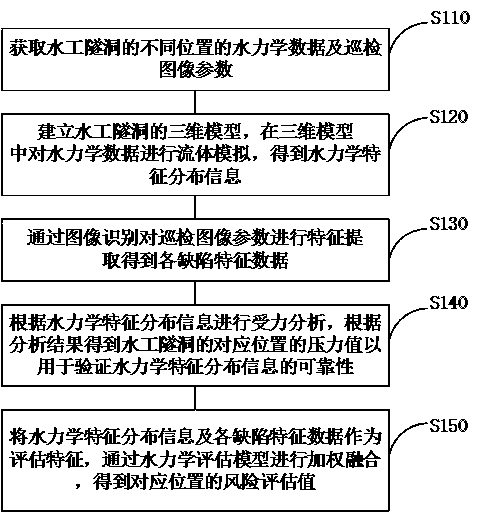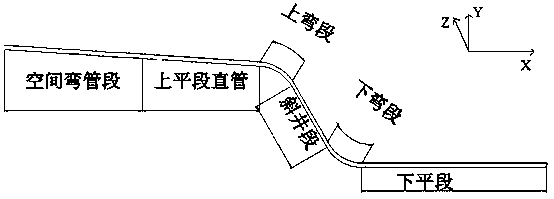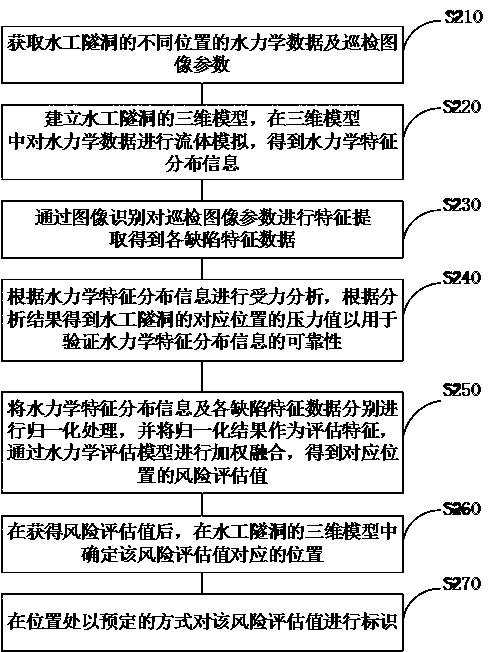Risk assessment method, device and terminal equipment for hydraulic tunnels
A risk assessment, hydraulic tunnel technology, applied in design optimization/simulation, instrumentation, electrical digital data processing, etc., can solve the problem of reducing the accuracy of safety assessment, difficult to give the specific location of hydraulic tunnel risks, and increasing maintenance of hydraulic tunnels. Cost and other issues, to achieve the effect of feasibility, reduced maintenance costs, and high evaluation accuracy
- Summary
- Abstract
- Description
- Claims
- Application Information
AI Technical Summary
Problems solved by technology
Method used
Image
Examples
Embodiment 1
[0051] figure 1 A schematic flowchart of a hydraulic tunnel risk assessment method provided by the first embodiment of the present invention is shown.
[0052] The hydraulic tunnel risk assessment method mainly includes the following steps:
[0053] In step S110, hydraulic data and inspection image parameters of different positions of the hydraulic tunnel are acquired.
[0054]Specifically, considering the influence of hydraulic data on the force of hydraulic tunnel pipelines and common defects of hydraulic tunnels, the main data that affect the safety of hydraulic tunnels are obtained, such as the area of the control basin, the proportion of the total basin area, the average flow rate for many years, Maximum dam height, normal storage level, operating water level during flood season, dead water level, total storage capacity, regulation performance, maximum water head, minimum water head, rated water head, etc.
[0055] The inspection image parameters can be the images of ...
Embodiment 2
[0117] image 3 A schematic flowchart of a hydraulic tunnel risk assessment method provided by the second embodiment of the present invention is shown.
[0118] The hydraulic tunnel risk assessment method mainly includes the following steps:
[0119] In step S210, hydraulic data and inspection image parameters of different positions of the hydraulic tunnel are acquired.
[0120] Step S210 is the same as step S110, and will not be repeated here.
[0121] In step S220, a three-dimensional model of the hydraulic tunnel is established, and fluid simulation is performed on the hydraulic data in the three-dimensional model to obtain hydraulic feature distribution information.
[0122] Step S220 is the same as step S120, and will not be repeated here.
[0123] In step S230, feature extraction is performed on the inspection image parameters through image recognition to obtain feature data of each defect.
[0124] Step S230 is the same as step S130, and will not be repeated here. ...
Embodiment 3
[0136] Figure 4 A schematic flowchart of a hydraulic tunnel risk assessment method provided by the third embodiment of the present invention is shown.
[0137] The hydraulic tunnel risk assessment method mainly includes the following steps:
[0138] In step S310, hydraulic data and inspection image parameters of different positions of the hydraulic tunnel are acquired.
[0139] Step S310 is the same as step S210 and will not be repeated here.
[0140] In step S320, a three-dimensional model of the hydraulic tunnel is established, and fluid simulation is performed on the hydraulic data in the three-dimensional model to obtain hydraulic feature distribution information.
[0141] Step S320 is the same as step S220, and will not be repeated here.
[0142] In step S330, feature extraction is performed on inspection image parameters through image recognition to obtain defect feature data.
[0143] Step S330 is the same as step S230 and will not be repeated here.
[0144] In st...
PUM
 Login to View More
Login to View More Abstract
Description
Claims
Application Information
 Login to View More
Login to View More - R&D
- Intellectual Property
- Life Sciences
- Materials
- Tech Scout
- Unparalleled Data Quality
- Higher Quality Content
- 60% Fewer Hallucinations
Browse by: Latest US Patents, China's latest patents, Technical Efficacy Thesaurus, Application Domain, Technology Topic, Popular Technical Reports.
© 2025 PatSnap. All rights reserved.Legal|Privacy policy|Modern Slavery Act Transparency Statement|Sitemap|About US| Contact US: help@patsnap.com



